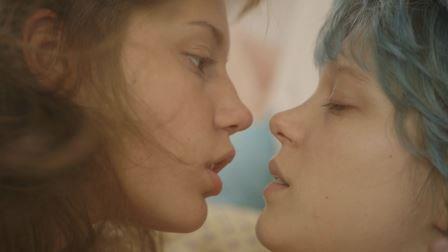Blue is the Warmest Color, Tunisian director Abdellatif Kechiche's film about a high school girl who falls in love at first sight with an art student with punk blue hair is the most beautiful film (so far) at Cannes. Three hours long, it is an indulgent pleasure to watch, mostly because the film consists, in great part, of close-ups of the lead actress' face, stunningly filmed in all its shifts of emotion, from longing to sexual ecstasy.
What happens in the three hours? A simple love story. No complicated plot. It's basically girl meets girl, girl falls in love with girl and then....

The purity of the storyline is matched by the purity of the shots. We see the two girls lying together in the grass; we see them---often--make love, with an animal passion that rivals the typical fare of heterosexual scenes; we see them meet each other's parents in their respective homes; we see the younger girl teach cute little children in a school.
The dialogues are what one would expect of a French couple: the two girls speak about Sartre and Impressionism, or about the latest art house film. The only edginess to their conversation is not about the fact that they are lesbian but the fact that they are from different social classes. The older girl, Emma ( Léa Seydoux), eats oysters in a home decorated with fine art paintings; the younger, Adele (Adele Exarchopoulos) ), eats spaghetti in a crowded kitchen with her uneducated family. Emma is ambitious to be a successful artist who shows in the best galleries, Adele will become an elementary school teacher.
We also have, ever so often, whimsical funny lines, like "Artists are people who make a living when they are dead."
Interestingly, for a three hour film focusing on one girl, we have little backstory psychology. We know nothing about the main girl's relationship to her family, or what influenced her to want to be a teacher. But we don't care. The story is all in the present moment: what it means to be profoundly in love, body and soul. It's one of the most convincing love stories on screen ever seen, like an exercise in sketching the contours of a universal experience.
I asked director Kechiche to discuss his choice of focussing on the faces of his characters.
"When doing my earlier films, I felt that the close-ups spoke more to me, and were more expressive and touching. They permitted me to capture the details that we normally do not perceive, even if we actually see them. Behind these details is an emotion, a sentiment, a state of being. Cinema can do the magic of exposing what is behind facial expressions, like a magnifying glass. The close-up forces you to be as close to the truth as possible. It manages to find the truth. If you film someone eating using a long or medium shot, the actor can pretend she is eating; but if you want to film someone eating with a close-up, the actor cannot lie. The close-up makes truth obligatory. One cannot make an illusion in the close-up."
But aren't these close-ups also aesthetic?
"The moment a face expresses a truth it becomes beautiful."
my close-up of Kechiche
The sex scenes, I noted to the director, are among the most complete and sensuous I have ever seen on camera. The bodies seem to be desperate to unite with each other, in every possible way. How does he, a man, know how to shoot lesbian sex?
"I think sexual acts are an expression of a secret language we all have, a language of the soul, and we could say that the soul has no gender. When two beings love each other, sex is just an expression of this language, in the search for communication and communion."

